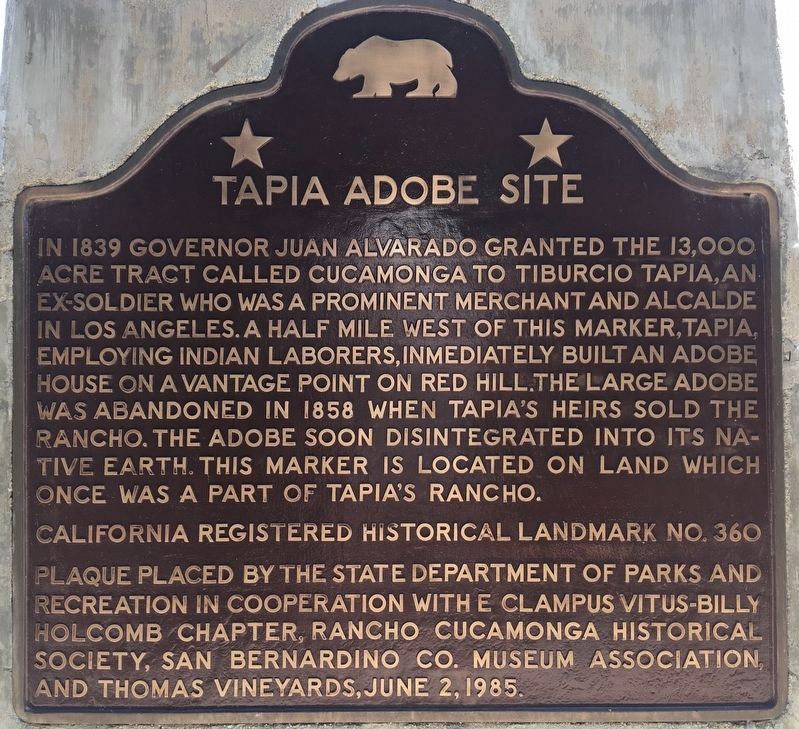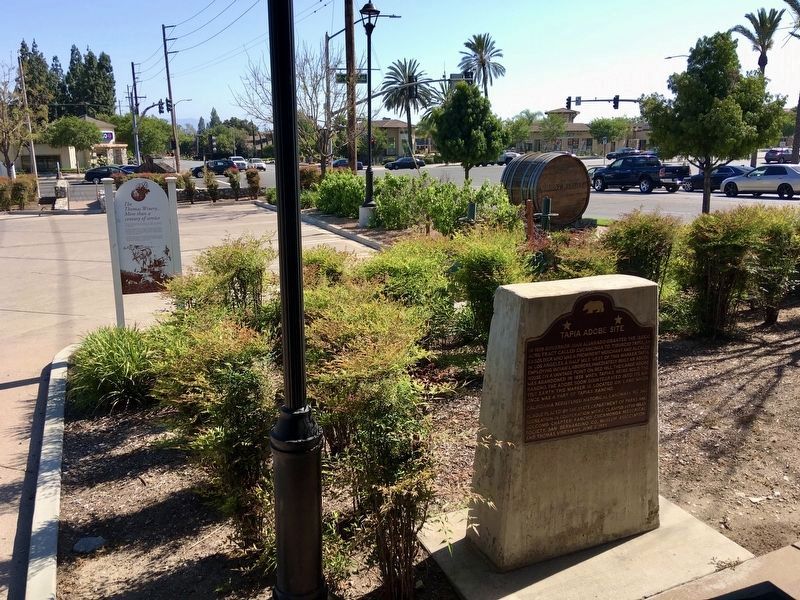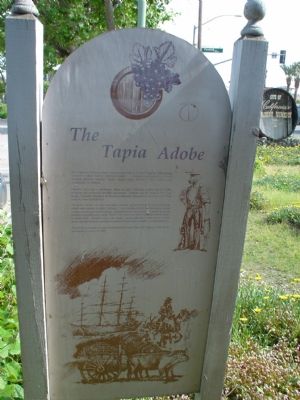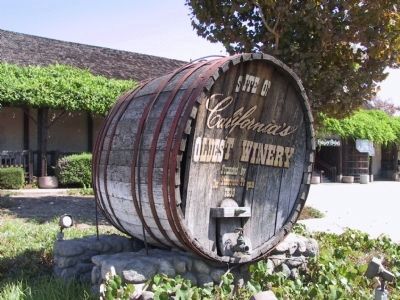Rancho Cucamonga in San Bernardino County, California — The American West (Pacific Coastal)
Tapia Adobe Site
Erected 1985 by State Department of Parks and Recreation in cooperation with E Clampus Vitus–Bill Holcomb Chapter, Rancho Cucamonga Historical Society, San Bernadino County Museum Association, and Thomas Vineyards. (Marker Number 360.)
Topics and series. This historical marker is listed in these topic lists: Hispanic Americans • Landmarks • Native Americans • Settlements & Settlers. In addition, it is included in the California Historical Landmarks, and the E Clampus Vitus series lists. A significant historical year for this entry is 1839.
Location. 34° 6.431′ N, 117° 36.649′ W. Marker is in Rancho Cucamonga, California, in San Bernardino County. Marker is at the intersection of Vineyard Avenue and Foothill Boulevard, on the right when traveling north on Vineyard Avenue. The marker is located at the Thomas Winery Plaza. The marker is facing away from traffic towards the restaurant. Touch for map. Marker is at or near this postal address: 8916 Foothill Boulevard, Rancho Cucamonga CA 91730, United States of America. Touch for directions.
Other nearby markers. At least 8 other markers are within walking distance of this marker. Cucamonga Winery (within shouting distance of this marker); Red Hill (within shouting distance of this marker); Cucamonga Labor Camp (approx. ¼ mile away); 1826 (approx. 0.3 miles away); 1839 (approx. 0.4 miles away); 1840s (approx. 0.4 miles away); 1858 (approx. 0.4 miles away); 1864 (approx. 0.4 miles away). Touch for a list and map of all markers in Rancho Cucamonga.
More about this marker. The site was formally occupied by the Thomas Winery. On an old wine cask beside Vineyard Avenue are the words "Site of California's Oldest Winery, founded by Don Tiburcio Tapia 1839." Don Tiburcio was rumored to have buried a treasure of coins. His ghost appeared to his daughter showing her where a few coins and a scrap of leather with markings on it had been hidden. The treasure remained undiscovered.
SOURCE: Billy Holcomb Chapter 1069 35th Anniversary Plaque Book by Phillip Holdaway
Regarding Tapia Adobe Site. (Text on the sign in Photo No. 3)
The Tapia Adobe.This 30 foot by 160 foot adobe structure was built by Tiburcio Tapia in 1839, and has witnessed a great deal of California history . . . a history punctuated by Catholic missions, Mexican rancheros, Yankee clipper ships, Butterfield stagecoaches and, occasionally, by violence.
Tiburcio Tapia was a prominent citizen of early California, soldier, guard, trader, merchant and eventually wealthy land-owner Tiburcio was 50 when in 1839 Juan Batista Alvarado, Governor of Mexican California, rewarded his loyalty with 13,000 acres of prime foothill land.
This area's "sticky" clay-like soils made excellent sun-dried bricks for adobe structures which were popular in early California. Their foot-thick walls of help to keep occupants warm in winter and cool in summer. Strengthened by the addition of straw or grass and shaped in wooden forms, damp "bricks" were left to dry in the sun before being stacked to create walls. Exterior walls were usually coated with white wash, wood or other water resistant material, and further protected from direct rainfall by overhanging roofs.
This adobe eventually was restored by Webster H. and Clifford H. Thomas whose father purchased the winery in 1918.
Credits. This page was last revised on March 23, 2023. It was originally submitted on May 28, 2006, by Joseph Beeman of Upland, California. This page has been viewed 4,783 times since then and 91 times this year. Last updated on May 7, 2020, by Craig Baker of Sylmar, California. Photos: 1, 2. submitted on May 8, 2020, by Craig Baker of Sylmar, California. 3. submitted on May 28, 2006, by Joseph Beeman of Upland, California. 4. submitted on December 18, 2011, by Michael Kindig of Elk Grove, California. • Syd Whittle was the editor who published this page.



